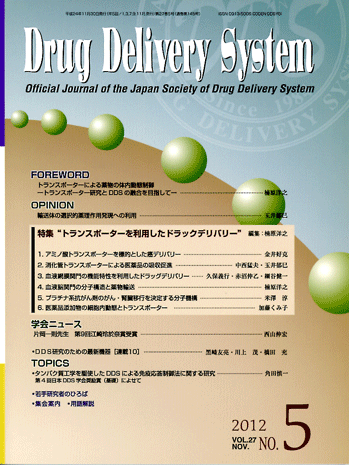All issues

Volume 27 (2012)
- Issue 5 Pages 342-
- Issue 4 Pages 246-
- Issue 3 Pages 156-
- Issue 2 Pages 76-
- Issue 1 Pages 10-
Volume 27, Issue 5
NOVEMBER
Displaying 1-6 of 6 articles from this issue
- |<
- <
- 1
- >
- >|
Feature articles “Transporters control intestinal pharmacokinetics of drugs” Editor:Hiroyuki Kusuhara
-
Yoshikatsu Kanai2012Volume 27Issue 5 Pages 342-349
Published: November 30, 2012
Released on J-STAGE: February 28, 2013
JOURNAL FREE ACCESSAmong amino acid transporters upregulated in tumor cells, LAT1 (SLC7A5) is the most favorable for the drug delivery to cancers due to its cancer-selective expression and broad substrate selectivity. LAT1 is responsible for the cancer delivery of anti-tumor phenylalanine-mustard melphalan and L-p-boronophenylalanine used for boron neutron capture therapy. LAT1 is also a target of PET imaging probe delivery. Most of amino acid probes target LAT1, whereas only FAMT is LAT1-selective. FAMT, therefore, exhibits the most remarkable cancer-selective accumulation. Cancer-selective drug design including the idea of amino acid-based pro-drugs would be possible based on the LAT1-selectivity and property as a LAT1 substrate.View full abstractDownload PDF (587K) -
Takeo Nakanishi, Ikumi Tamai2012Volume 27Issue 5 Pages 350-360
Published: November 30, 2012
Released on J-STAGE: February 28, 2013
JOURNAL FREE ACCESSIntestinal absorption is a pharmacokinetically important step to determine pharmacological efficacy of drugs because it affects bioavailability of drugs; however, it is not an easy task to create orally effective drug due to difficulty in providing with sufficient intestinal absorption. Current evidence shows that membrane transporters affect drug absorption and disposition, suggesting that they are potentially useful to adjust pharmacokinetic properties of drugs. This review will summarize the recent information regarding transporter-mediated intestinal absorption of drugs and introduce key membrane transporters with their contribution to drug absorption. In addition, this will also discuss about possible applications of transporters to enhance intestinal permeability of drugs which are highly soluble but poorly permeable to biological membrane, focusing on, in particular, H+-coupled oligopeptide transporter, PEPT1View full abstractDownload PDF (1640K) -
Yoshiyuki Kubo , Shinichi Akanuma, Ken-ichi Hosoya2012Volume 27Issue 5 Pages 361-369
Published: November 30, 2012
Released on J-STAGE: February 28, 2013
JOURNAL FREE ACCESSThe blood-retinal barrier (BRB) forms tight junction of retinal capillary endothelial cells (inner BRB) and retinal pigment epithelial cells (outer BRB) to prevent the free diffusion of substances between the circulating blood and the neural retina, and maintain the retinal homeostasis. Retina is an important tissue involved in vision, of which disorders and diseases can produce a marked drop in the quality of life in patients. To improve the therapy of severe retinal diseases, such as diabetic retinopathy, it is essential to design simpler and more effective routes for drug delivery to the retina, and it has been proposed that the transporters at the BRB are useful for the retinal drug delivery. In this review, the transporter-mediated vitamin C and verapamil transports are introduced as the transport mechanisms for nutrients and drugs across the BRB.View full abstractDownload PDF (1209K) -
Hiroyuki Kusuhara2012Volume 27Issue 5 Pages 370-380
Published: November 30, 2012
Released on J-STAGE: February 28, 2013
JOURNAL FREE ACCESSBlood-brain barrier(BBB) is formed by brain capillary endothelial cells. Because of highly developed tight junction between the adjacent cells, the cells act as diffusion barrier to isolate central nervous system from the blood circulation. To order to develop CNS acting drugs, the not only the Systemic eyposave but also permeability across the BBB needs to be optimized. Various transporters are expressed in the BBB, and facilitate the exchange of nutrients and metabolites between the CNS and blood. They are available as target molecule to improve the CNS penetration. In addition, P-gp and Bcrp actively extrude their substrate into the blood at the BBB, and thereby, limit the CNS penetration of drugs. Avoiding these transporters is another strategy to improve CNS penetration of drugs. Kinetic analysis suggests the expression of a transporter which facilitates the penetration of lipophilic cationic drugs, such as clonidine, diphenhydramine and D2 receptor antagonists in rodents and human BBB. These transporters are potentially target transporters to optimige drug deliver into the CNS. This manuscript summarized the current knowledge on the transporters expressed in the BBB.View full abstractDownload PDF (624K) -
Atsushi Yonezawa2012Volume 27Issue 5 Pages 381-388
Published: November 30, 2012
Released on J-STAGE: February 28, 2013
JOURNAL FREE ACCESSPlatinum agents are widely used in current clinical. They exhibit different features, especially in nephrotoxicity, although their toxicological mechanisms are similar. Transporter mediates target delivery of drugs, according to the substrate specificity, tissue distribution and functional characteristics. Recent findings showed that Organic cation transporter OCT and Multidrug and toxin extrusion MATE play important roles in drug delivery of platinum agents. This manuscript summarized topics of delivery of platinum agents to the cancer and kidney via transporters.View full abstractDownload PDF (604K) -
Kumiko Sakai-Kato2012Volume 27Issue 5 Pages 389-398
Published: November 30, 2012
Released on J-STAGE: February 28, 2013
JOURNAL FREE ACCESSFor the development of DDS products, excipients attract lots of attention and the appropriate selection and evaluation of excipients are expected. In this review, the author overviews the evaluation of excipients. The author also presents the recent studies concerning the intracellular trafficking processes from intracellular uptake to extracellular efflux of the excipients which are used as drug carrier, and the involvement of transporters in the efflux of excipients from the cells.View full abstractDownload PDF (765K)
- |<
- <
- 1
- >
- >|